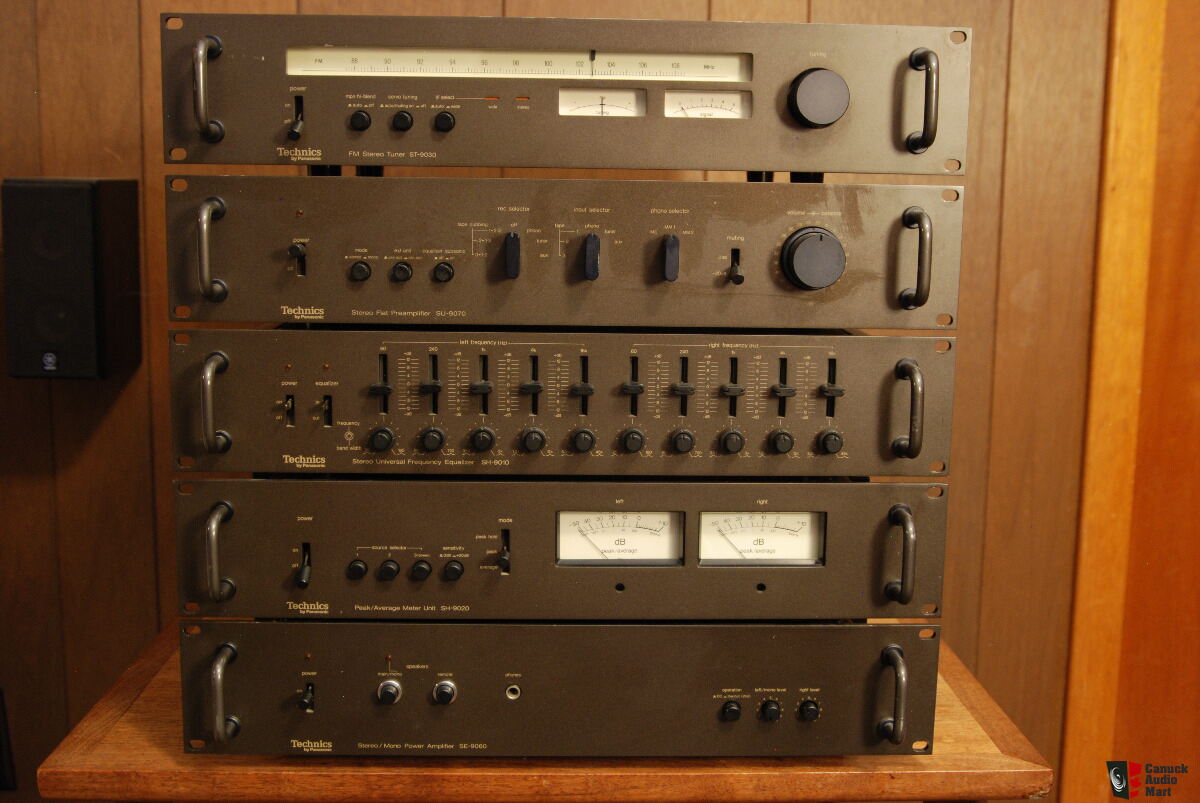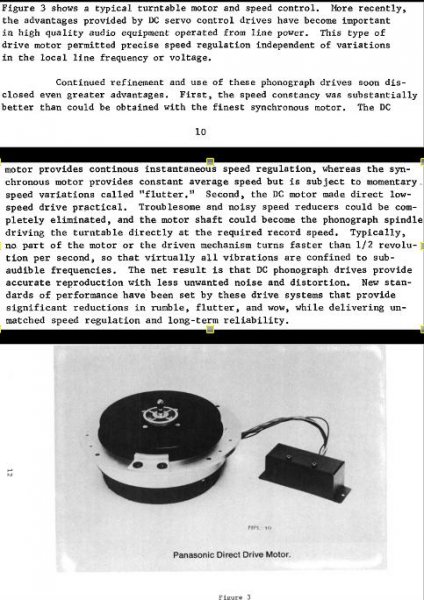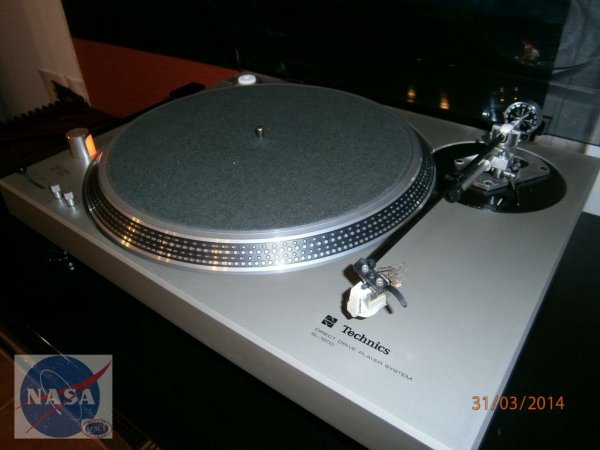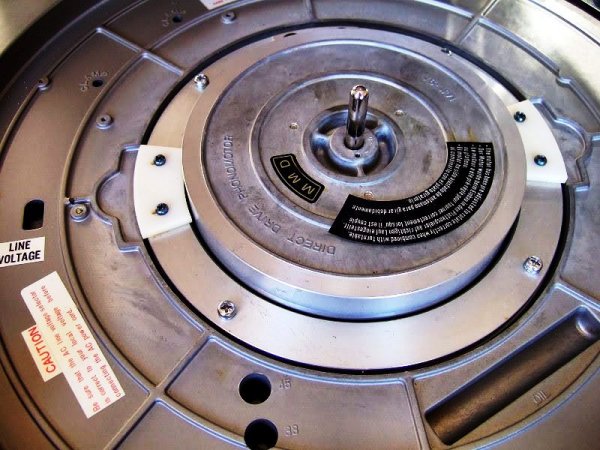70's and early 80's Japanese Component: How good were they?
- Thread starter FrantzM
- Start date
You are using an out of date browser. It may not display this or other websites correctly.
You should upgrade or use an alternative browser.
You should upgrade or use an alternative browser.
I always was (more than slightly ) amused by the notion, of: how Accuphase had grown out of KENWOOD (though, the 1978-era "KA 9000"-series model integrateds *do* look like hand-me-down E-202's...so, they can be surprising performers at bargain prices if sellers don't know that). As for Japanese speakers: except for Yamaha NSM's, the majority of speakers from Japan (in the '70s) were junk knockoffs of the JBL 100 (they all started making the woofer cones white!) meant to be sold in packaged deals with the corresponding imported receiver (as the twentysomething college student of-the-day did not have an extra $650 for a pair of genuine article Centuries, circa 1973).
) amused by the notion, of: how Accuphase had grown out of KENWOOD (though, the 1978-era "KA 9000"-series model integrateds *do* look like hand-me-down E-202's...so, they can be surprising performers at bargain prices if sellers don't know that). As for Japanese speakers: except for Yamaha NSM's, the majority of speakers from Japan (in the '70s) were junk knockoffs of the JBL 100 (they all started making the woofer cones white!) meant to be sold in packaged deals with the corresponding imported receiver (as the twentysomething college student of-the-day did not have an extra $650 for a pair of genuine article Centuries, circa 1973).
(Vintage) Yamaha turntables are absolutely a pristine and worthwhile investment. They were (generally) built from Micro-Seiki parts (the highest end vintage Japanese turntable brand) while other international conglomerates were outsourced to Chuao-Denki Electric Company ("C.E.C."). [The biggest joke in the vintage market is the absurd price, for example, a 1976 Marantz 6300 DD turntable goes for: around $500(!). Underneath it all, it's just a generic Technics 1600/Sansui FR-5080 clone with a woodgrain plinth. However...the thing so funny about it(?): a 95% *identical* model, made by C.E.C. as well, badged for RADIO SHACK as a "Realistic Lab-400" can be had for less than $150!]
Yamaha, Onkyo, and Denon were the mainstream Asian brands which really came into their own starting in the early '80s. Unfortunately, Sansui really went downhill and never recovered (personally: the sound quality of pre-1977 Sansui, IMO, was far above what the brute power of Pioneer and the more budget-aimed Kenwood delivered). (Vintage) Sansui, to me, seems to not have trouble with more inefficient speakers also...UNlike, the Superscope-era Marantz 2200-series receivers all the rage now and insanely OVERpriced (in my experience with those: no matter how much one thought a higher model number was going to denote more -reliable- power available, they seemed to just shoehorn-in the same power supply across so many models while pushing a bigger output stage to its design limitations...the reason SO many collecting these units are often pairing them with 97db efficient Klipschorns and not big A.R.'s or Advents! ).
).
I don't think Technics, for instance, was ever considered "audiophile-grade" in the U.S.; because: it was too closely associated with PANASONIC (here) and the branding had changed around 1974, when there was a large push toward trying to sell Quadraphonic (which the audiophile press had never accepted anyway). The 1200 was ostracized mainly, at the time, because THORENS had become a major market player in America concerning *serious* LP playback (with Acoustic Research still in the game with its "B" and "C" upgrades of the "XA" turntable all the way until 1985). Out of all the reel to reel decks I've had, I've yet to own a Technics 1500-series. I wish, though, the 7" "RS-777" version of it had been available as a 120v model...because, I WOULD go after that one(!).
(Vintage) Yamaha turntables are absolutely a pristine and worthwhile investment. They were (generally) built from Micro-Seiki parts (the highest end vintage Japanese turntable brand) while other international conglomerates were outsourced to Chuao-Denki Electric Company ("C.E.C."). [The biggest joke in the vintage market is the absurd price, for example, a 1976 Marantz 6300 DD turntable goes for: around $500(!). Underneath it all, it's just a generic Technics 1600/Sansui FR-5080 clone with a woodgrain plinth. However...the thing so funny about it(?): a 95% *identical* model, made by C.E.C. as well, badged for RADIO SHACK as a "Realistic Lab-400" can be had for less than $150!]
Yamaha, Onkyo, and Denon were the mainstream Asian brands which really came into their own starting in the early '80s. Unfortunately, Sansui really went downhill and never recovered (personally: the sound quality of pre-1977 Sansui, IMO, was far above what the brute power of Pioneer and the more budget-aimed Kenwood delivered). (Vintage) Sansui, to me, seems to not have trouble with more inefficient speakers also...UNlike, the Superscope-era Marantz 2200-series receivers all the rage now and insanely OVERpriced (in my experience with those: no matter how much one thought a higher model number was going to denote more -reliable- power available, they seemed to just shoehorn-in the same power supply across so many models while pushing a bigger output stage to its design limitations...the reason SO many collecting these units are often pairing them with 97db efficient Klipschorns and not big A.R.'s or Advents!
I don't think Technics, for instance, was ever considered "audiophile-grade" in the U.S.; because: it was too closely associated with PANASONIC (here) and the branding had changed around 1974, when there was a large push toward trying to sell Quadraphonic (which the audiophile press had never accepted anyway). The 1200 was ostracized mainly, at the time, because THORENS had become a major market player in America concerning *serious* LP playback (with Acoustic Research still in the game with its "B" and "C" upgrades of the "XA" turntable all the way until 1985). Out of all the reel to reel decks I've had, I've yet to own a Technics 1500-series. I wish, though, the 7" "RS-777" version of it had been available as a 120v model...because, I WOULD go after that one(!).
I had my own share of Sansui, Yamaha and Technics back in the day, and I can tell you first hand, that the Technics were just OK and only the high end cassette decks and R2R stood out; Yamaha was fine, at that time; never liked the Sansui.
For example, despite the fact I have spent around to $200K on the current system, I still have most of the 9000 Series Technics below from that era (picture sourced from google) in a 3rd system:

In particular, the tuner right now sounds OK and it can use new caps; the preamp underneath it is OK (love the three tape inputs, two phono); the equalizer below that is hooked up to the tuner to give it life (love the fact I can tune the center frequency, frequency width and volume of each of the operating equalizers); and the mono amp on the bottom (with variable gain nobs on the right) sounds OK. The RM-M85 deck I also had was far superior, but sold it. I tried to buy a top-of-the-line M95 a couple of years back from ebay, and it was junk and not representative of original quality.
I can easily say I would NEVER seek any audio equipment from that era, other than a modified 1500 R2R. I am actually surprised that Yamaha is reviving integrated amps from that era, as if they can't design something more modern; but perhaps it sounds good now?!?!?
By contrast, my Revox B77II is still with me, and still sounds fabulous with the right program, and haven't updated anything in it. Basically, there was "high end" and high end back then.
For example, despite the fact I have spent around to $200K on the current system, I still have most of the 9000 Series Technics below from that era (picture sourced from google) in a 3rd system:

In particular, the tuner right now sounds OK and it can use new caps; the preamp underneath it is OK (love the three tape inputs, two phono); the equalizer below that is hooked up to the tuner to give it life (love the fact I can tune the center frequency, frequency width and volume of each of the operating equalizers); and the mono amp on the bottom (with variable gain nobs on the right) sounds OK. The RM-M85 deck I also had was far superior, but sold it. I tried to buy a top-of-the-line M95 a couple of years back from ebay, and it was junk and not representative of original quality.
I can easily say I would NEVER seek any audio equipment from that era, other than a modified 1500 R2R. I am actually surprised that Yamaha is reviving integrated amps from that era, as if they can't design something more modern; but perhaps it sounds good now?!?!?
By contrast, my Revox B77II is still with me, and still sounds fabulous with the right program, and haven't updated anything in it. Basically, there was "high end" and high end back then.
Last edited:
Thank you very much!
Here is mine:
NASA SPACE CERTIFIED (By National Panasonic Technics)
View attachment 16117
And here is NASA's reaction:
Recorded phone call by NASA and sended to me by email:
"- Hello there! Are you Hellenic Vanagon? NASA is speaking!
-Hello!
-You are stupid!
-Sir?
-NASA did not , do not and will not certify any damned TECHNICS turntable.
We are the most spectacular team on the planet, and are not going to bother with you and with your gatzets, bloody Greeks!
(After all, here we like Linn with Lingo, you know...).
-But sir, how did you find me?
-Our global surveyor satellite finds anything!
We order you to delete any idiotic post you have done in any site!
-Sir, recalling human rights, I am not going to accept that!
Believe it or not, you are not the only super power any more!
Chinese vehicle is walking on the moon!
-You said Chinese! Ya, we know , ASUS, CAV, etc. etc..
Go immediately and turn on your Chinese stereo and tell me if works!
- But why? Any way, just a moment please!
No it does not work at all!
- See? Don’t ever tell me about China and Chinese products!
-I am going to fight you!
-You are dead!"
(O.k., just a joke)
Just in case someone is interested.
Here is NASA's, near, certification:

NASA Link


Last edited:
Nice thread, some of you guys are walking talking history books. 
Regarding the Linn LP12, I had a chance to hear one in a local stereo store about ten years ago.
What I recall is an inability to prevent my toe tapping as it does with live music.
It didn't seem to need to be a slugger with a killer KO knock out punch of bass because it could out box and dance in the ring so gracefully.
I think for 60's and 70's Rock & Roll the brute force of direct drive is a real winner, however on everything else the Linn LP12 can hold it's own in my opinion.
Again, weigh my opinion as you will with my limited exposure to that table (and others mentioned).
Regarding the Linn LP12, I had a chance to hear one in a local stereo store about ten years ago.
What I recall is an inability to prevent my toe tapping as it does with live music.
It didn't seem to need to be a slugger with a killer KO knock out punch of bass because it could out box and dance in the ring so gracefully.
I think for 60's and 70's Rock & Roll the brute force of direct drive is a real winner, however on everything else the Linn LP12 can hold it's own in my opinion.
Again, weigh my opinion as you will with my limited exposure to that table (and others mentioned).
I have a fully loaded LP12 /Circus/Lingo with Naim ARO tonearm. This is fully loaded per 1991 spec. It sounds very good.
I bought a Pioneer Exclusive P3 several years ago. This is a 1979/80 table. My best HiFi buy, especially considering the price.
This is a superior sounding table to the LP12. It has better bass control with a larger soundstage and is fast - that is the notes start and stop in a faster manner. The LP12 sounds distant and small in scale in comparison.
I also bought P3's little brother P10 which is also very good, but a level below the great P3.
http://www.thevintageknob.org/pioneer-Exclusive_P3.html
You should try and pick up a L-07 - great table as well.
View attachment 7843
The table pictured above looks very much like my friend's Denon.
Any relation?
EDIT:
Found this.
http://www.thevintageknob.org/pioneer-Exclusive_P3.html
EMT notwithstanding, the Exclusive P3 was the winner of the large test made by the Stereo Sound staff in 1980 and is, undoubtedly, the most successful high-end & high-priced turntable in Japan !
The table pictured above looks very much like my friend's Denon.
Any relation?
EDIT:
Found this.
http://www.thevintageknob.org/pioneer-Exclusive_P3.html
No relation. A lot of the Japanese DD tables of that era looked superficially similar.
The Denon DP-100M was their best table.
http://www.thevintageknob.org/denon-DP-100M.html
There were many, robustly-built Japanese audio electronics on the audio market in the 1970s. Where they were notably weak was on loudspeakers, but there were many bad loudspeakers of all origins, then, so that was a matter of degrees of terribleness, not binary. In electronics, the Superscope-era Marantz amplifiers, receivers, integrated amps and preamps were both excellent for the time and can still hold up today. Common items like the 22XX series receivers; the 1200, 1120, 1090, 1060/70, 1030/40 integrateds; the 3300 and especially 3600 preamp; and the 500, 250, 240, 150 power amps. I owned several of these models during that decade. Kenwood, Pioneer, Sansui, Technics, Sony, Yamaha, Akai, Harman-Kardon all had a similar tier. The Marantz models generally sounded more musically convincing that Pioneer equivalents at the time. Kenwood was in league with Marantz. After 1976, Yamaha emerged with a somewhat more nuanced sound. Technics models in amplification were the most variable. Sansui was quite far behind but often had the most features (i.e. buttons). In the Zu Audio world, it's fairly common for younger buyers to pair a vintage Marantz receiver or integrated amp with Zu Omens, or Omen Def. I see this happen in the Klipsch market, too. And they acquit themselves quite well.
Luxman then was a cut above, and did cost a little more. Tandberg (Norway) leveraged their reputation in tape recorders to challenge Luxman in this upper mass market specialty tier in the '70s. Luxman of the '70s was uniformly musical in electronics, and their high end amps, led by the m3045b, a Tim de Paravicini push-pull triode (using a proprietary power triode) were in the same sonic class as Audio Research.
But what really sticks in collective memory more were the fabulous Japanese electro-mechanical machines of 1970s audio -- turntables, reel-to-reel tape decks, cassette decks. It was in these machines that the engineering, machining, design, manufacturing and execution prowess of Japan's consumer electronics industry was vividly obvious. Forget about what you think about competing turntable drive philosophies -- a 1970s upper end Technics, Luxman, Kenwood, Luxman, Sony or Pioneer turntable made a Linn Sondek or Thorens turntable look like an insincere joke. A US-made AR was a pathetic example of manufactured product, even compared to same-price entry-level Japanese turntables.
I have two Luxman PD-444 direct drive, dual tonearm turntables that have been in use continuously since they were bought in 1977 and 1979 respectively. I've had Linn, Pink Triangle, VPI, Technics, Rega and others alongside at various times over the past 40+ years. So far, the Luxmans stay. The tonearm I use most is a Stax UA-70, circa 1970 origins. I also have Japan Victor UA-7045 & UA-7082 tonearms from the era on one of the Luxman 444s. Luxman anticipated several things with the PD441/444 that newer turntable builders rediscovered. The plinth is a sandwich of iron plate, chipboard and aluminum, bolted together under tension. The motor was bespoke for Luxman by Tokyo Electric. I made one change, ten years ago, that markedly improved the turntable: The 1970s thinking that a mass-loaded (these things weigh over 60 lbs.) turntable should be supported by damped spring leveling feet has been superseded. With some extensive experimentation I arrived at replacing the stock feet with 1 lb. brass cones, attached to the turntable by thin polymer adhesive discs, and the cones are seated on receptors that are mounted on bearings. This brought the Luxman into the present with jump factor, greater resolution and a new level of bass performance without losing any of the turntable's intrinsic musicality.
The Pioneer, Sony, Teac, Dokorder, Akai, and later Technics reel-to-reel machines were similarly magnificent, and the rebirth of R2R is most often enabled by reborn Japanese decks from this era. In cassettes, a long parade of machines poured out of Pioneer, Marantz, Kenwood, Technics, Dokorder,, Teac, Denon, Akai, Sansui, Harman-Kardon, others.
Unfortunately, as the true mass market that was hifi when Boomers were in college, began to dissipate with the rise of many competing interests for cash, from video to accessible skiing, during the 1980s. And as hifi moved from hifi stores to bigger box retailers, they demanded from the industry packaged systems that less -knowledgeable sales people could sell. So we got flooded with cheap "rack systems" with the plastic content rising and the metal content falling. Luxman got bought by Alpine, the car audio folks. Marantz changed hands, Sony focused on video, TVs, portable audio. Kenwood, Technics, Sansui faded. The receiver pretty much died. CD eventually ploughed under the high-R&D turntables and tape decks. The boom-box became a big, garish thing. And high end audio went ever-higher during the greed-is-good audio-is-status years. The mass market retreated into headphones fed by a Walkman.
In the 1970s hifi had a mass constituency and it made objects of desire average people could afford, and wanted to. See those scenes in movies set in the 1970s, with audio system components on bookshelves shelves? Lots of apartments, dorms and houses looked exactly like that then.
Phil
Luxman then was a cut above, and did cost a little more. Tandberg (Norway) leveraged their reputation in tape recorders to challenge Luxman in this upper mass market specialty tier in the '70s. Luxman of the '70s was uniformly musical in electronics, and their high end amps, led by the m3045b, a Tim de Paravicini push-pull triode (using a proprietary power triode) were in the same sonic class as Audio Research.
But what really sticks in collective memory more were the fabulous Japanese electro-mechanical machines of 1970s audio -- turntables, reel-to-reel tape decks, cassette decks. It was in these machines that the engineering, machining, design, manufacturing and execution prowess of Japan's consumer electronics industry was vividly obvious. Forget about what you think about competing turntable drive philosophies -- a 1970s upper end Technics, Luxman, Kenwood, Luxman, Sony or Pioneer turntable made a Linn Sondek or Thorens turntable look like an insincere joke. A US-made AR was a pathetic example of manufactured product, even compared to same-price entry-level Japanese turntables.
I have two Luxman PD-444 direct drive, dual tonearm turntables that have been in use continuously since they were bought in 1977 and 1979 respectively. I've had Linn, Pink Triangle, VPI, Technics, Rega and others alongside at various times over the past 40+ years. So far, the Luxmans stay. The tonearm I use most is a Stax UA-70, circa 1970 origins. I also have Japan Victor UA-7045 & UA-7082 tonearms from the era on one of the Luxman 444s. Luxman anticipated several things with the PD441/444 that newer turntable builders rediscovered. The plinth is a sandwich of iron plate, chipboard and aluminum, bolted together under tension. The motor was bespoke for Luxman by Tokyo Electric. I made one change, ten years ago, that markedly improved the turntable: The 1970s thinking that a mass-loaded (these things weigh over 60 lbs.) turntable should be supported by damped spring leveling feet has been superseded. With some extensive experimentation I arrived at replacing the stock feet with 1 lb. brass cones, attached to the turntable by thin polymer adhesive discs, and the cones are seated on receptors that are mounted on bearings. This brought the Luxman into the present with jump factor, greater resolution and a new level of bass performance without losing any of the turntable's intrinsic musicality.
The Pioneer, Sony, Teac, Dokorder, Akai, and later Technics reel-to-reel machines were similarly magnificent, and the rebirth of R2R is most often enabled by reborn Japanese decks from this era. In cassettes, a long parade of machines poured out of Pioneer, Marantz, Kenwood, Technics, Dokorder,, Teac, Denon, Akai, Sansui, Harman-Kardon, others.
Unfortunately, as the true mass market that was hifi when Boomers were in college, began to dissipate with the rise of many competing interests for cash, from video to accessible skiing, during the 1980s. And as hifi moved from hifi stores to bigger box retailers, they demanded from the industry packaged systems that less -knowledgeable sales people could sell. So we got flooded with cheap "rack systems" with the plastic content rising and the metal content falling. Luxman got bought by Alpine, the car audio folks. Marantz changed hands, Sony focused on video, TVs, portable audio. Kenwood, Technics, Sansui faded. The receiver pretty much died. CD eventually ploughed under the high-R&D turntables and tape decks. The boom-box became a big, garish thing. And high end audio went ever-higher during the greed-is-good audio-is-status years. The mass market retreated into headphones fed by a Walkman.
In the 1970s hifi had a mass constituency and it made objects of desire average people could afford, and wanted to. See those scenes in movies set in the 1970s, with audio system components on bookshelves shelves? Lots of apartments, dorms and houses looked exactly like that then.
Phil
Similar threads
- Replies
- 5
- Views
- 2K
- Replies
- 18
- Views
- 2K
- Replies
- 2
- Views
- 2K
- Replies
- 224
- Views
- 22K
- Replies
- 3
- Views
- 3K
| Steve Williams Site Founder | Site Owner | Administrator | Ron Resnick Site Owner | Administrator | Julian (The Fixer) Website Build | Marketing Managersing |

